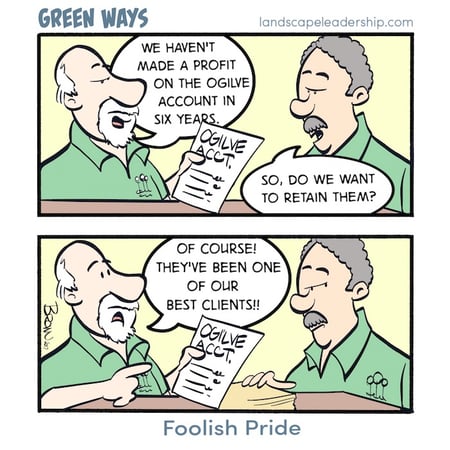Topics: Growth
Use This Proven Framework to Manage Your Production Capacity (and to Increase Profit/Customer)
 Author: Chris Heiler
Author: Chris Heiler
 In my last article I suggested you limit your production capacity at least until you reach the profit margins you desire.
In my last article I suggested you limit your production capacity at least until you reach the profit margins you desire.
In this article I'll give you some tips on how to manage your capacity. But, first, a caveat to this discussion...
The stronger your positioning the easier it will be to manage your company's capacity for work, and thus reap the benefits that come along with this strategy.
On the flip side, a full service one-stop-shop trying to be all things to all people will have a difficult time managing production capacity in a logical and strategic way as compared to a company with a crystal clear identity.
A framework for managing your production capacity
Let's create a fictitious company to serve as an example. We'll say Big Al's Gardening offers fine gardening and estate management to high-end residential properties in the Dallas Fort Worth metro area.
In 2018 they did $1m in revenue with 60% of revenues from maintenance contracts, 30% from enhancement work (from these same contracts), and 10% from holiday decor services.
Big Al's earned 5% net profit on this $1m, leaving the company with $50,000 in profits at the end of the year. For even more context, we'll say Al – the owner – pays himself a salary of $70,000 annually.
Big Al's currently has 100 customers spending on average $10,000 each year with the company. Big Al realizes this is too many customers to manage and he's not taking home as much money as he would like.
His goal is 15% profit netting $150k at year end. He wants to cap his customer count around 65 while maintaining his $1m in revenue.
Here's what I would suggest:
1. Create three classes of customers, organized by annual spend
For Al, who wants a more manageable 65 customers at any one time, he might structure his capacity like this:
- A Customers- 15 to 20, spend over $20k annually
- B Customers- 32 to 40, spend over $15k annually
- C Customers- 6 to 10, spend over $10k annually
This example is quite extreme considering Big Al's current customers spend $10k on average. It'll take him more time to achieve this, but you get the point: You have to consistently raise the value of each customer while adhering to a minimum level of engagement (MLOE; $10k/year in this case).
Now, Al needs to categorize his current customers into these three classes. What he finds is that half of his customer base isn't even spending the minimum $10,000/year.
Huh... and he wonders why he is overworked?
2. It's time to let go of some customers
Running a successful small business isn't easy. It takes a tremendous amount of courage to make extremely difficult decisions, such as letting go certain customers.
Of course, this is one reason why the majority of companies in our industry are average and haven't reached the level of success they aspire to- they are unable or unwilling to make difficult decisions like this.
But you're different. And so is Big Al.
Big Al is going to start by letting go of all of his unprofitable customers that are spending less than $10,000 each year with him. These are the accounts that:
- They are over-servicing
- They are underpricing
- They are traveling too far to service
- Or, in most instances, a combination of the above
Bottom line: There is a large chunk of customers they are making scraps on. That needs to end.
3. Let's raise prices
 Raising prices is the quickest way to increase your bottom line profitability.
Raising prices is the quickest way to increase your bottom line profitability.
Al may raise some prices across all his customers, but more importantly, he will look at each customer individually to determine who is profitable and who isn't and then raise prices accordingly.
He knows damn well he is going to lose some customers who are unwilling to pay a higher price for his services. That's fine because he knows many of these customers are not profitable anyway. Time to let them fall aside.
4. Focus relentlessly on growing your best accounts and replacing others who don't meet your capacity requirements
Big Al has a lot of work to do. Now he needs to grow his existing accounts so the majority of them are spending over $15,000 each year. That's not easy.
Not only that, they need to replace their $10k/year accounts with $20K+ accounts. Again, not easy.
I make it sound simple using this example but, of course, it is anything but simple. It takes time to identify what your ideal capacity should be and then even more time and persistence to actually fill it.
Profitability doesn't come easy, my friends.
In the case of Big Al's Gardens, this is most likely a three year process (minimum) with a small step backwards in total revenue in the early stages. But, he's sacrificing the short term for the long term health of his company and for his personal quality of life.
I hope you'll consider doing the same for yourself.
---
Read the previous article about the many benefits of limiting your production capacity
Want more insight like this delivered straight to your inbox? Subscribe to our blog here or add your email to the form below.




